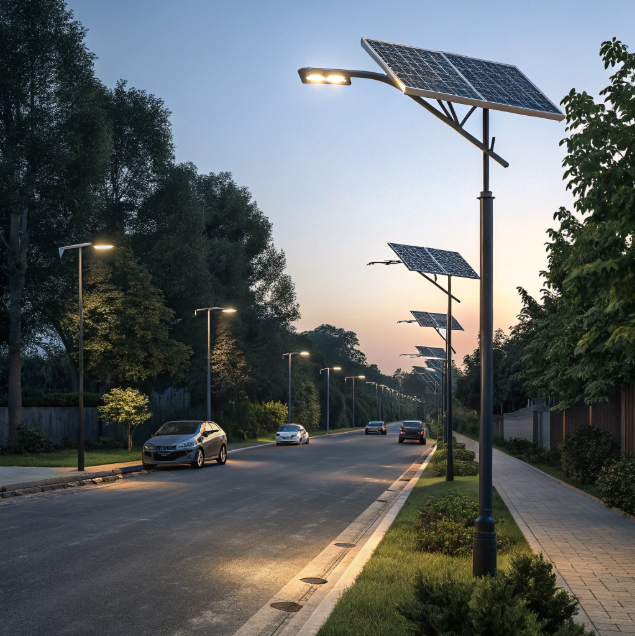Zero Electric Bills vs. ROI: A Financial Breakdown for Your Municipal Project to See When Solar Street Lights Pay for Themselves
by
Zero Electric Bills vs. ROI: A Financial Breakdown for Your Municipal Project to See When Solar Street Lights Pay for Themselves
Municipalities face rising energy costs and budget constraints. Solar street lights[^1] eliminate electricity bills while requiring upfront investment.
Solar street lights typically achieve ROI within 3-7 years through eliminated electricity costs[^2], reduced maintenance, and avoided trenching expenses, making them financially viable long-term solutions for municipal lighting projects.
Understanding the financial equation behind solar street lighting is crucial for municipal decision-makers. Let's break down when these investments truly pay off.
All-in-One vs. Split-Type: A Project Manager's Guide to Choosing the Right Solar Street Light and Avoiding Costly Mistakes
Struggling to decide between integrated and separate solar systems? The wrong choice could waste thousands.
All-in-one solar lights[^3] offer easier installation and unified maintenance, while split-type systems provide better performance in challenging conditions and allow component-specific upgrades.
Critical Factors in Solar Light Selection
Choosing between all-in-one and split-type systems requires understanding your project's specific needs. All-in-one units combine solar panel, battery, and LED light in a single housing, making them ideal for quick deployments and areas with minimal vandalism concerns. Their streamlined design reduces installation complexity and costs significantly.
Split-type systems separate components, allowing optimal placement of solar panels for maximum sun exposure while keeping batteries in protected locations. This separation enables larger battery capacities and higher-wattage panels for demanding applications like main roads or areas with partial shading.
| Feature | All-in-One | Split-Type |
|---|---|---|
| Installation Complexity | Low (1-2 hours) | Moderate (3-4 hours) |
| Maintenance Accessibility | Limited | Component-specific |
| Performance in Low Light | Standard | Enhanced |
| Vandalism Risk | Higher | Lower |
| Customization Options | Limited | Extensive |
The decision ultimately depends on your specific municipal requirements. For parking lots and residential streets, all-in-one systems often provide the best balance of cost and performance. For industrial areas or main thoroughfares, split-type systems[^4] deliver superior reliability and performance.
Does Your Street Light Need Permits and a Construction Crew? How Solar Helps You Bypass Complex Approvals and Installation Nightmares
Frustrated by endless permit applications and disruptive construction? Solar lighting offers a streamlined alternative.
Solar street lights typically bypass electrical permits and complex construction since they don't require grid connection, trenching, or electrical infrastructure work, significantly reducing approval timelines and installation complexity.
Traditional grid-connected lighting projects often face months of permit approvals, environmental assessments, and utility coordination. Solar lighting eliminates most of these hurdles because they're self-contained systems that don't interact with public utilities or require extensive underground work.
Most municipalities classify solar street lights as "temporary structures" or "equipment installations," which fall under simpler permit categories. Many jurisdictions even have expedited processes for renewable energy installations, recognizing their environmental benefits and reduced infrastructure impact.
Key advantages include:
- No electrical service applications
- Minimal ground disturbance
- Reduced environmental impact assessments
- Faster deployment timelines
The installation process itself is dramatically simplified. Instead of coordinating multiple crews for trenching, electrical work, and utility connections, solar installations typically require just a concrete foundation and pole erection. This reduction in complexity can cut project timelines from months to weeks.
From Parking Lots to Main Roads: How to Perfectly Configure Your Solar Lighting Plan with Lumens, Height, and Pole Spacing
Worried about underlighting or overspending on your solar project? Proper configuration ensures optimal performance.
Effective solar lighting configuration requires matching lumen output, pole height, and spacing to specific applications, with parking lots needing 20-30 foot spacing at 15-20 feet height, while main roads require 80-120 foot spacing at 25-30 feet height for adequate coverage and safety.
Technical Specifications for Different Applications
Getting the technical details right ensures your solar lighting project delivers both safety and efficiency. Each application type has distinct requirements that impact both performance and cost.
For parking lots and pedestrian areas, focus on uniform illumination with minimal dark spots. These applications typically use 4,000-8,000 lumens at 15-20 foot mounting heights. The closer spacing ensures even light distribution and enhances security by eliminating shadows where people gather.
Main roads and thoroughfares require higher mounting heights and brighter outputs to cover wider areas and provide adequate visibility for vehicle traffic. These installations typically range from 10,000-20,000 lumens at 25-30 foot heights, with wider spacing to control costs while maintaining safety standards.
| Application | Lumen Range | Pole Height | Spacing | Notes |
|---|---|---|---|---|
| Parking Lots | 4,000-8,000 | 15-20 ft | 20-30 ft | Uniform coverage critical |
| Residential Streets | 6,000-10,000 | 20-25 ft | 40-60 ft | Balance safety and cost |
| Main Roads | 10,000-20,000 | 25-30 ft | 80-120 ft | Higher speeds require better visibility |
| Pathways | 2,000-4,000 | 12-15 ft | 15-25 ft | Lower heights for pedestrian scale |
Proper configuration also considers local climate conditions, with northern regions typically requiring larger solar panels and battery capacities to account for reduced winter sunlight. Southern regions can often use smaller systems due to more consistent solar exposure.
Conclusion:
Solar street lights deliver significant financial and operational benefits, typically paying for themselves within 3-7 years while simplifying municipal approvals and installation processes.
[^1]: Explore the advantages of solar street lights, including cost savings and environmental benefits for municipalities.
[^2]: Learn how solar street lights can significantly reduce energy expenses for municipalities.
[^3]: Explore the benefits of all-in-one solar lights for quick installations and reduced complexity.
[^4]: Learn how split-type systems can enhance performance and customization for specific municipal needs.
Popular Posts
You may also be interested in:




